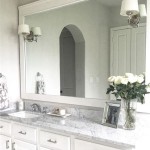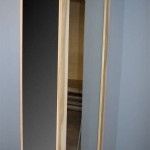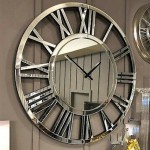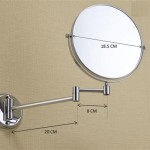Round Mirrors: Elevating Tabletop Aesthetics
Mirrors, in their myriad forms, have long been employed as decorative elements, capable of enhancing spaces and reflecting light in ways that amplify both visual appeal and perceived size. Among the diverse applications of mirrors, their use on tables, particularly in the form of round mirrors, stands out as a versatile and impactful design choice. Round mirrors for tables offer a blend of functionality and aesthetics, capable of serving as elegant centerpieces, practical bases for displays, or subtle embellishments that elevate the overall ambiance of a room.
The incorporation of round mirrors onto tables isn't a new concept, but its enduring popularity stems from its adaptability to various styles and settings. From minimalist modern interiors to opulent classical environments, round mirrors can seamlessly integrate and contribute to the desired aesthetic. Their reflective properties not only brighten the immediate surroundings but also create a sense of depth and spaciousness, making them particularly valuable in smaller rooms or areas with limited natural light.
The versatility of round mirrors extends to their application across different types of tables. They can be found gracing dining tables, coffee tables, side tables, console tables, and even outdoor tables. The choice of size, material, and overall design can significantly impact the final look, allowing for a tailored approach to suit specific needs and preferences. Ultimately, the successful integration of round mirrors into a tabletop design hinges on careful consideration of various factors, including the table's size and shape, the surrounding décor, and the intended purpose of the mirror.
Enhancing Visual Appeal and Creating Focal Points
One of the primary benefits of using round mirrors on tables is their ability to enhance visual appeal and create focal points. A strategically placed round mirror can draw the eye and serve as a central element around which the rest of the décor is arranged. This is especially effective on dining tables, where a round mirror can be used as a base for a stunning centerpiece, such as a floral arrangement, candle display, or sculptural object. The mirror's reflective surface amplifies the beauty of the centerpiece, creating a more dramatic and impactful visual statement.
On coffee tables or side tables, a round mirror can be used to add a touch of glamour and sophistication. It can be paired with decorative objects, such as vases, books, or small sculptures, to create an interesting and visually appealing vignette. The mirror's reflective properties will not only enhance the appearance of these objects but also create a sense of depth and dimension, making the table feel more curated and thoughtfully designed.
Furthermore, the reflective qualities of a round mirror can be used to create interesting optical illusions. By strategically positioning the mirror, it is possible to reflect and amplify certain elements of the décor, making a room feel larger or more symmetrical. This technique is particularly useful in smaller spaces, where every trick to enhance the perceived size of the room is valuable.
Amplifying Light and Creating a Sense of Spaciousness
Another significant advantage of incorporating round mirrors onto tables is their ability to amplify light and create a sense of spaciousness. Mirrors, by their very nature, reflect light, and this property can be particularly useful in rooms with limited natural light. By placing a round mirror on a table, you can reflect the available light back into the room, making it feel brighter and more airy.
This effect is amplified when the mirror is placed near a window or other light source. The mirror will capture the natural light and bounce it around the room, effectively doubling the amount of light available. This can be particularly beneficial in rooms that tend to be dark or gloomy, as it can instantly brighten the space and create a more cheerful atmosphere.
In addition to amplifying light, round mirrors can also create a sense of spaciousness. The reflective surface of the mirror creates the illusion of depth, making a room feel larger than it actually is. This is especially effective when the mirror is placed on a table that is located near a wall, as it can create the impression that the room extends beyond the wall.
The size of the mirror is also a factor in determining the extent to which it can amplify light and create a sense of spaciousness. A larger mirror will generally reflect more light and create a greater sense of depth than a smaller mirror. Therefore, when choosing a round mirror for a table, it's important to consider the size of the room and the amount of light available.
Protecting Table Surfaces and Enhancing Functionality
Beyond their aesthetic contributions, round mirrors can also serve practical purposes on tables. They can act as a protective barrier for delicate table surfaces, preventing scratches, stains, and heat damage. This is particularly useful for tables made of wood, glass, or other materials that are susceptible to damage.
By placing a round mirror under a decorative object, such as a vase or candle holder, you can prevent the object from scratching or staining the table surface. The mirror will act as a buffer, absorbing any pressure or heat that might otherwise damage the table. This is especially important for tables that are used frequently or that are located in high-traffic areas.
Furthermore, round mirrors can enhance the functionality of a table by providing a stable and level surface for objects to rest on. This is particularly useful for tables that are not perfectly level or that have uneven surfaces. By placing a round mirror under an object, you can create a stable base that will prevent the object from tipping over or sliding off the table.
Round mirrors can also be used to create a rotating display surface. By placing a round mirror on a swivel base, you can create a platform that can be easily rotated, allowing you to view objects from all angles. This is particularly useful for displaying sculptures, collectibles, or other items that are meant to be admired from all sides.
Different types of round mirrors offer unique benefits and considerations for tabletop use. Beveled mirrors, for example, feature angled edges that create a sophisticated and elegant look. These mirrors can add a touch of formality to a dining table or console table, making them suitable for more upscale settings. However, beveled edges can also be more susceptible to chipping or damage, requiring careful handling.
Antiqued mirrors, on the other hand, possess a distressed finish that adds character and vintage charm. These mirrors work well in rustic or bohemian-inspired interiors, lending a sense of history and authenticity to the space. However, the aged finish can affect the mirror's reflectivity, potentially reducing its ability to amplify light.
Frameless mirrors offer a clean and minimalist aesthetic that complements modern and contemporary décor. Their seamless design integrates seamlessly with any tabletop setting, without adding visual clutter. However, frameless mirrors lack the protection of a frame, making their edges more vulnerable to damage.
When selecting a round mirror for a table, it's crucial to consider the size and shape of the table itself. A mirror that is too large can overwhelm the table and make it feel cluttered, while a mirror that is too small may get lost in the surrounding décor. As a general rule, the mirror should be approximately one-third to one-half the size of the table's surface area.
The shape of the table should also be taken into account. On a round table, a round mirror is a natural choice that reinforces the table's overall shape. On a rectangular or square table, a round mirror can provide a contrasting shape that adds visual interest and breaks up the straight lines. However, it's important to ensure that the proportions are balanced and that the mirror doesn't appear out of place.
The placement of the round mirror on the table is also a critical factor. Consider the overall design of the room and the specific purpose of the table. On a dining table, the mirror should be positioned in the center to serve as a focal point for the centerpiece. On a coffee table, the mirror can be placed off-center to create a more dynamic and asymmetrical arrangement.
Ultimately, the successful integration of round mirrors onto tables hinges on a thoughtful approach that considers the specific context and desired aesthetic. By carefully selecting the right size, material, and design, and by strategically positioning the mirror on the table, it is possible to create a visually appealing and functionally enhanced tabletop display that elevates the overall ambiance of the room.

Consoles Round Mirrors Centsational Style

Console Tables And Round Mirrors A Perfect Combination

Set Of 6 Round Glass Mirrors Decorative Table Wedding Decor

Eastland Round Table Mirror 16 Set Of 6 Candles4less

Round Table Wall Mirror Trays Circle Candle Plates Temu United Arab Emirates

Petoor Gold Round Mirror With Base Large Circle Mirrors For Ubuy

10 Diameter Round Glass Table Mirrors Count For Wedding And Party Centerpieces Beautiful Vases Or Decor

Kate And Laurel Maxfield 21 5 In X 18 Modern Round Black Framed Decorative Wall Mirror 221277 The Home Depot

Round Glass Mirror Wedding Banquet Table Centerpieces Smooth Edges Sets Of 12 Pcs Com

Do It Yourself Over Sized Round Mirror Statement For Under 200 Living Room Decor Home








